After all of the innovations and refinements Fender made to the Stratocaster since its introduction in 1954, Leo Fender was starting to slow down in the early ’60s. The main reason was a persistent streptococcal infection that sapped his strength and caused him no small degree of suffering.
Concerned he wouldn’t be able to muster the energy to guide what he had already accomplished, nor continue to surprise and delight guitarists and bassists with newer and even more groundbreaking ideas, Fender sold his namesake company to Columbia Record Distributors—a division of the mighty CBS—for $13 million in 1965. That’s approximately $2 million more than CBS paid for the New York Yankees baseball franchise in 1964, and around $128 million in today’s money. For a more comprehensive look at Fender before, during and after CBS, see our article, The History of the Fender Stratocaster.
It’s no secret the transition from a small shop concerned with inventiveness and quality to a large corporate division beholden to spreadsheets, streamlined production processes and profit margins was often uncomfortable for the Fender team.
CBS certainly qualified as a ’60s version of Star Trek’s Borg, and as the mega-corporation was not overly burdened by Fender tradition, it initiated changes to the Stratocaster—as well as the Telecaster, Precision Bass, Twin Reverb guitar amp and pretty much everything else the company manufactured.
The two decades of CBS ownership have been disparaged—even vilified—by those who believe Fender product quality suffered due to numerous “profit-enriching” decisions. But, as you’ll discover in this article, there’s more to the story than “clickbait-style” scorn. Let’s take a brief—and open-minded—look at the whys, wherefores and ramifications of the Columbia Broadcasting System acquisition of Fender, and how specifically CBS management impacted the Fender Stratocaster.
If you want to learn more about the origins and early history of the Strat, check out 1954—1965 | The Evolution of the Fender Stratocaster.
Table of Contents
CBS Motivations for Buying Fender
Changes to the Stratocaster During the CBS Ownership of Fender
Larger Headstock
Micro-Tilt Neck
Three-Bolt Neck Attachment
Bullet Truss Rod
Fender Tuning Machines
Finishes
Five-Position Pickup Selector
Pickups
Bridges and Saddles
Pickguard Material
Fingerboard Inlays
An Objective Assessment of Fender Stratocaster Guitars During the CBS Years
The End of CBS Ownership
Back to the '70s
CBS Motivations for Buying Fender
There was a significant wave of corporate takeovers in the 1960s—perhaps due to aggressive anti-trust enforcement (which often blocked mergers of companies in the same industry) and stalled growth from mature core operations (making it attractive to seek revenue increases in unrelated businesses).
For its part, broadcasting company CBS embraced the concept of diversification during the ’60s. CBS acquired magazine publishers (and titles such as Woman’s Day), sports teams (most notably the aforementioned New York Yankees), toy companies (Ideal, Gabriel, etc.), film distributors, record labels, cutting-tool maker X-Acto and, of course, Fender and Rhodes electric pianos.
As an investment opportunity, a popular and expanding musical instrument company such as Fender likely appeared to be extremely attractive—which may be why the CBS offer to Leo Fender was the highest ever paid for a single music-instrument manufacturer at the time. We can assume a big part of the Fender company’s appeal was that CBS saw ways to streamline operations, reduce costs, make more guitars (and achieve more sales) and identify savvy investments in manufacturing and other areas that could serve to grow profits down the line.
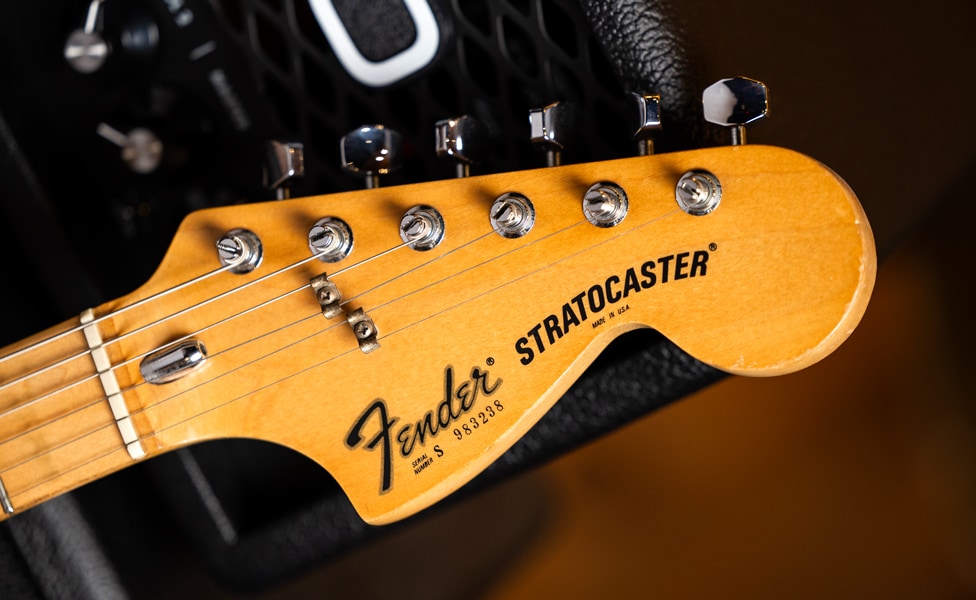
Pictured: 1980 Fender Stratocaster Headstock
In fact, CBS did go to work optimizing production and profits, building new plants and delegating Leo’s old factories to predominantly storage and repair warehouses. But while CBS leadership could usually find ways to improve “widget manufacturing” of any type, its skill set lacked a critical element for producing guitars, basses and amps.
These were business minds. They were not musicians.
And even though CBS owned Columbia Records—which introduced an astounding enhancement to music enjoyment with the high-fidelity, long-playing (LP) record in 1948—devising a better medium to listen to music, and perfecting the instruments that make music, are two very different activities.
That said, the spirit of innovation that guided CBS throughout its core business as a broadcaster was still evident during its stewardship of a guitar maker—even as the company endeavored to squeeze as much profit out of Fender as possible.
Changes to the Stratocaster During the CBS Ownership of Fender
CBS did not impose its business strategies upon Fender the instant after the ink dried on the purchase contracts. Changes were somewhat gradual, and much of the primary Fender team was still in place—at least for a while. In addition, Leo, as a contracted “special consultant” to CBS, hung around for approximately four years. As his health improved, however, he began envisioning—and designing products for—the companies that would become Music Man and G&L.
But changes did come to the Stratocaster—whether initiated by CBS management, the Fender team or outside forces (player and retail requests, etc.). Here’s a list of the significant modifications ...
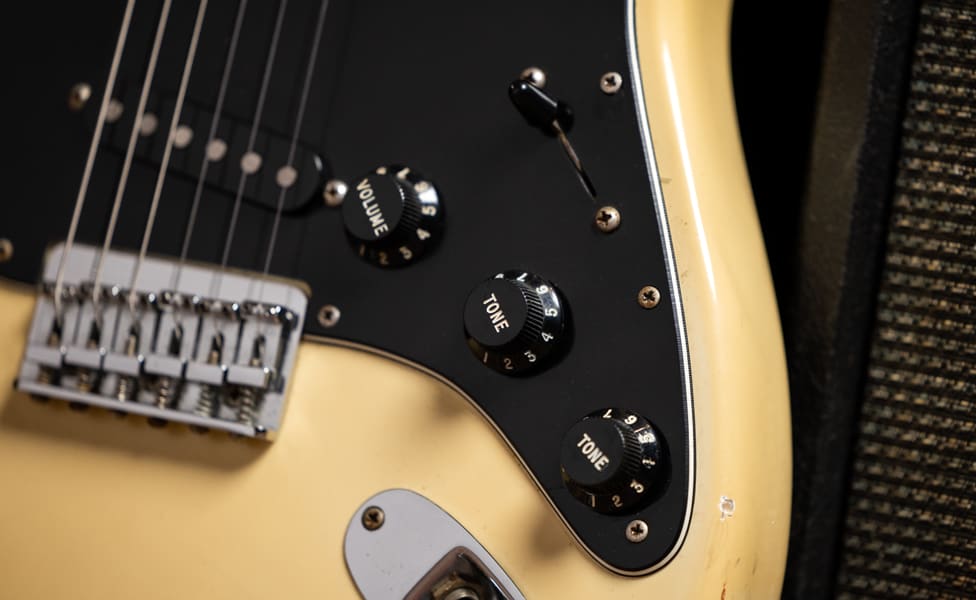
Pictured: 1980 Fender Stratocaster Control Knobs and 5-Way Pickup Selector
Larger Headstock
One of the first changes to the Stratocaster under CBS was a big ol’ headstock. However, it was an idea that was allegedly considered by Leo Fender and Fender designer/engineer Freddie Tavares to increase mass and sustain in 1964. It didn’t do precisely what it was intended to do, but the larger size did allow a more prominent Fender logo to be added to the headstock. “The rationale was simple,” stated author Richard R. Smith in Fender: The Sound Heard ’Round the World. “The new design allowed a bigger decal.”
Micro-Tilt Neck
Introduced around 1971, and designed by Leo Fender (with Freddie Tavares), the Micro-Tilt neck is a leverage mechanism that allows adjustment of the neck angle in small increments via an Allen wrench placed into a hole in the neck plate. Prior to Micro-Tilt, neck angles were typically a trial-and-error operation that required the use of shims. Benefits were initially two-fold: players could lower the action themselves, and/or solve any build-quality issues with the neck pocket (misalignment of screws, pocket too big, etc.). However, some believe the Micro-Tilt feature can cause air gaps between neck and body, as well as promote neck warping near the heel.
Three-Bolt Neck Attachment
The change to a three-bolt neck from a four-bolt arrangement around 1971 wasn’t because CBS wanted to reduce bolt costs (that’s a joke, BTW). In fact, for the Micro-Tilt system to work properly, the neck joint had to allow some movement. The easy fix was going to a less stable three-bolt attachment.
Bullet Truss Rod
Here’s yet another 1971 alteration initiated by the Micro-Tilt system, which required a metal disk recessed into the heel of the neck. As the disk inhabited some of the area needed for truss rod adjustments, Leo simply repositioned the access point to the headstock, capping the apparatus with a bullet-shaped nut.
Fender Tuning Machines
In 1967, Fender replaced the Kluson Deluxe tuning machines with Fender “F” keys made at the factory. Obviously, crafting homegrown tuning machines meant Fender no longer had to purchase Klusons. But if this was a cost-cutting measure, it wasn’t initiated by CBS. Fender’s Don Randall wanted the switch made to Fender tuning machines as soon as possible after the CBS sale.
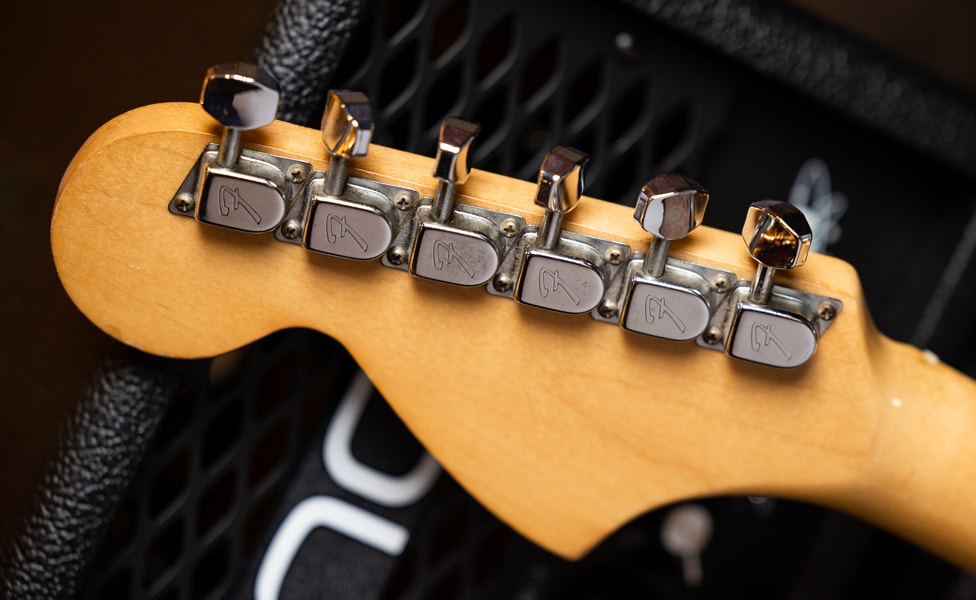
Pictured: 1980 Fender Stratocaster Tuning Machines
Finishes
CBS discontinued the use of nitrocellulose lacquer overcoats in 1968. Fender had used nitrocellulose lacquer since the beginning, but it’s toxic, and was, in fact, banned by the EPA in 1974. The replacement was polyurethane, which dries fast and is shiny and durable—perfect if you want to speed up production in the shop. However, Fender workers tended to spray a lot of polyurethane, which produced the thick finishes of CBS-era Stratocasters (as opposed to thin-skin Strats of the ’50s and early ’60s). While some players describe thick-skin Stratocasters as being drier sounding than pre-CBS models, several factors (pickups, wood, bridge, etc.) impose extensively more tonal impact on a guitar than its finish.
Five-Position Pickup Selector
You can file this one under “Why Did It Take Fender 23 Years to Offer a Five-Position Switch?” CBS certainly got this one right. Before the five-position switch was implemented in 1977, Stratocasters had a three-position pickup selector—one for each pickup. But players quickly discovered that by precariously balancing the switch in between the notched pickup positions (bridge/middle or neck/middle), they could get funky, snarling or beautifully hollow sounds. Lawrence Welk’s guitarist Buddy Merrill figured it out in 1955, and icons such as Eric Clapton, Rory Gallagher, Buddy Guy and Dick Dale followed suit. In fact, you could argue that Mark Knopfler’s exquisite out-of-phase Strat tone on Dire Straits’ “Sultans of Swing” is as much responsible for it being a smash hit as the songwriting, audio production and singing. The five-position switch finally made it easy to access some of the Stratocaster’s most compelling and legendary tones.
Pickups
One can imagine that CBS execs were not nostalgic over Fender’s hand-guided pickup wire winders. (“Now, there’s a production back up waiting to happen.”) In 1965, automated winders replaced old-school tech. This change may have caused some initial confusion over translating hand winding ratios to auto winding (resulting in somewhat hotter or slightly lower-output pickups), but more critically, CBS replaced Fender’s innovative staggered-height polepieces (for balancing string volume) for small, flush polepieces around 1974. The result was a less dimensional sound. In addition, CBS halted wax potting and also changed the wire gauge and coating (cloth to plastic)—a move that made CBS-era Fender single-coils microphonic and prone to feedback.
Bridges and Saddles
In the pre-CBS years, the Fender Synchronized Tremolo system employed a separate bridge plate and milled-steel inertia block. In 1970–1971, the system was changed to a one-piece, diecast part crafted from a metal alloy called Mazak. The original bent-steel saddles were also switched to diecast Mazak. There’s no way to position this one other than a cost-cutting measure, and the impact on string vibration somewhat affected the Strat’s tone.
Pickguard Material
The Strat pickguard changed twice during the Fender regime. In 1954, it was constructed from one piece of celluloid. Then, in 1959, Fender produced pickguards made from three layers of white celluloid. Over time, the top layer of these pickguards would degrade due to UV light and exposure to oxygen, revealing the mint-green hue that is prized by collectors and devotees of vintage Strats. After the sale to CBS, the pickguard material was changed to a pristine and more durable ABS vinyl that stayed bright white.
Fingerboard Inlays
We’re not certain if the change from clay—actually vulcanized fiberboard—to pearloid dot inlays on the fretboard was a cost-control measure, an aesthetic choice or a matter of more readily available materials. The switch actually began in 1964, before the CBS acquisition, and it may have been prompted by Leo himself—who was always looking for parts deals. In any case, CBS stuck with pearloid dots.
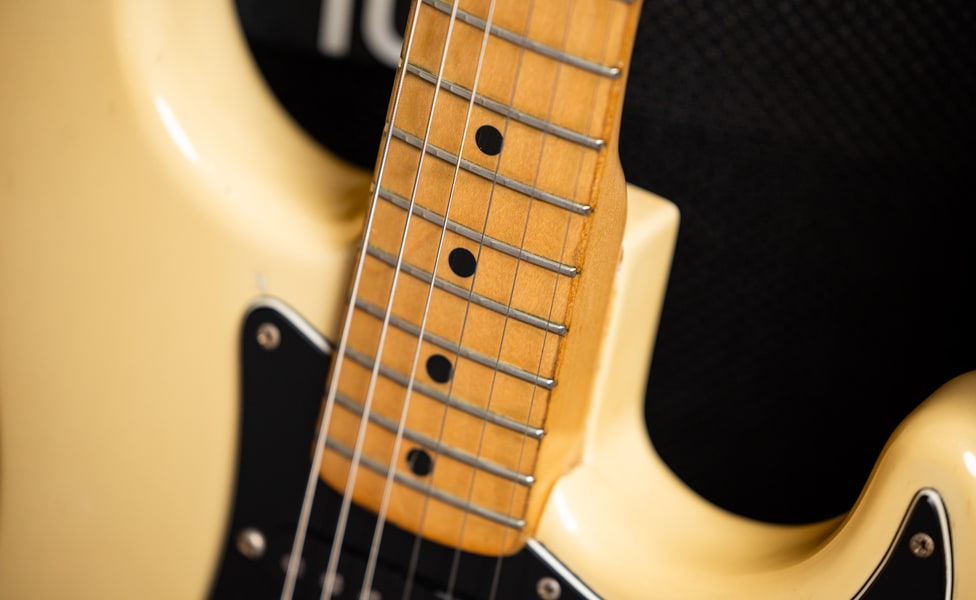
Pictured: 1980 Fender Stratocaster Maple Neck with Black Dot Inlays
An Objective Assessment of Fender Stratocaster Guitars Manufactured During the CBS Years
The reputation of CBS-era Stratocasters is not all that simple to define, and discussions on the matter can easily veer into an exercise of “point/counterpoint.” Get ready …
Let’s assume the most common perception is that CBS tactics to maximize profits via cost cuts, streamlined production and increased output caused quality to decline. That’s not entirely wrong.
“I hated the factory mentality of numbers, numbers, numbers,” said John Page, the co-founder and former head of the Fender Custom Shop, who worked at the company during the CBS era. “Quantity was the most important thing. It sucked.”
But CBS did increase profits and production, and it put a lot of Stratocasters—and other Fender products—into the hands of happy players. Don Randall, who was with Leo from almost the beginning, negotiated the CBS deal, and was vice president and general manager of Fender from 1965–1969, acknowledged the growth—though he ended up not being a fan of corporate fiefdoms and infighting.
“We went from around $11 million in sales the year we sold the company to CBS in 1965, to $19 million in 1966 and $21 million in 1967,” Randall told author Tony Bacon. “We were extremely successful and extremely profitable.”
Back to the quality issue. Context is everything, and a fair assessment of the CBS years at Fender also requires considering what other guitar companies were able to produce during the same period.
After all, before the guitar manufacturing industry widely adopted CNC machines and other precise and automated production technologies, much of the work on guitars was done by talented yet fallible, human beings. Today, you can grab practically any guitar off the rack at your local Guitar Center, and it will likely play like a dream and offer excellent build quality.
Shopping for guitars in the late 1960s and ’70s was not really like that, due to variances in wood, tone, feel, electronics and fit and finish. Guitar buyers at the time—whether they were looking for models from Fender, Gibson or another maker—sometimes had to audition several instruments of the same make to find one that had everything constructed just right and also felt like their guitar.
“We often hear that Fender went downhill after CBS bought them,” author and Guitar Player editor emeritus Tom Wheeler told Tom Watson of Guitar International magazine in 2007 (Wheeler was considered by many as one of the leading experts on Fender history). “There is always a grain or more of truth to those things, but there’s a lot more behind such statements. I think it’s important to look at these things not just from our perspective today. I’m really interested in what CBS was thinking in the late ’60s, ’70s and ’80s, and how Fender design reflected that thinking.”
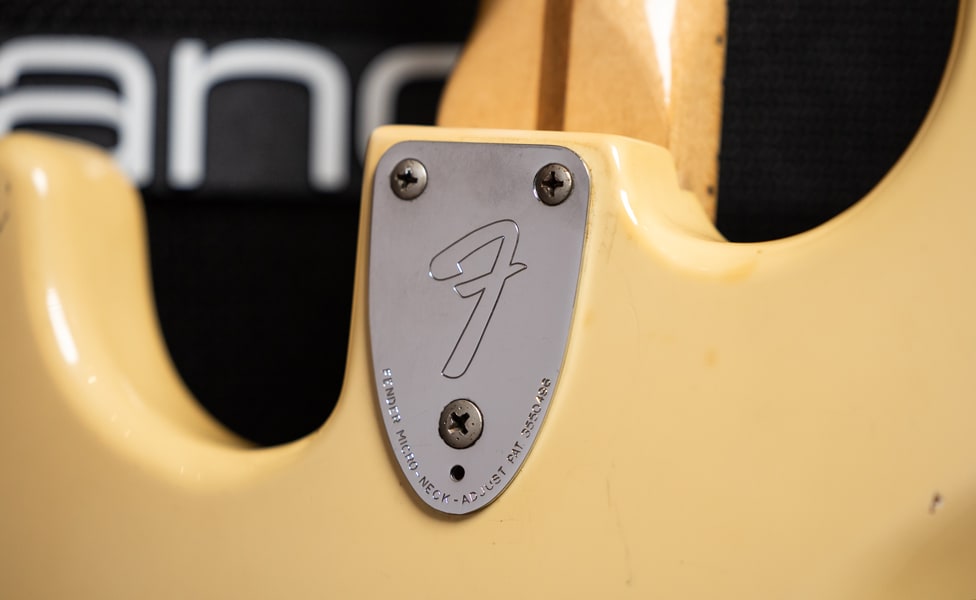
Pictured: 1980 Fender Stratocaster 3-Bolt Neck Plate with Micro-Tilt Adjustment
Perceptions of CBS quality lapses are likely the main reasons Pre-CBS Stratocaster guitars are often more valuable to collectors and vintage Fender aficionados than CBS models. But CBS Stratocasters can hardly be broadly defined as undesirable.
“While not as collectible as 1950s and early 1960s Stratocasters, CBS-era Strats continued to sound fantastic and represent great investment opportunities for musicians and collectors alike,” says Jack Hetherington, Director of Used and Vintage at Guitar Center. “For me, the big headstocks are super cool, and the sunburst finishes were some of the most vibrant and beautiful of all the 1960s Strats.”
During his interview with Bacon, Randall also took issue with opinions that CBS management willfully sought to diminish product quality.
“CBS did so many stupid things, but I don’t think they affected the product,” he remembered. “There’s always this suspicion when a big company takes over that they are going to make a lousy product and sell it for a higher price. That’s not true here. I will say this for CBS—they were just as interested in quality as we were. They spared no amount of time or effort to ensure the quality was there. It was simply a different approach and a different entity.”
Randall’s conviction aside, it’s a distinct possibility that no one—including those that were there—is going to convince a pre-CBS enthusiast that CBS leadership was anything but deadly to both Fender’s reputation and the quality of its guitars.
So, we’ll just leave you with this to ponder …
“How many photos have you seen with Jimi Hendrix playing a vintage Stratocaster?” asked Wheeler. “Zero. He wasn’t interested. He was playing off-the-shelf, late ’60s Strats that vintage purists wouldn’t be caught dead with. But they seemed okay for Jimi Hendrix.”
The End of CBS Ownership
After initial successes, what Randall called the “burden” of the CBS corporate structure began to erode profits.
“Everything became about the pecking order,” he recalled, “and everything was charged to the corporate overhead. Suddenly, I got loaded up with engineers I didn’t need, and all of these systems analysts. They divided everything into a cost center—every nut, bolt and screw. It became an impossible situation.”
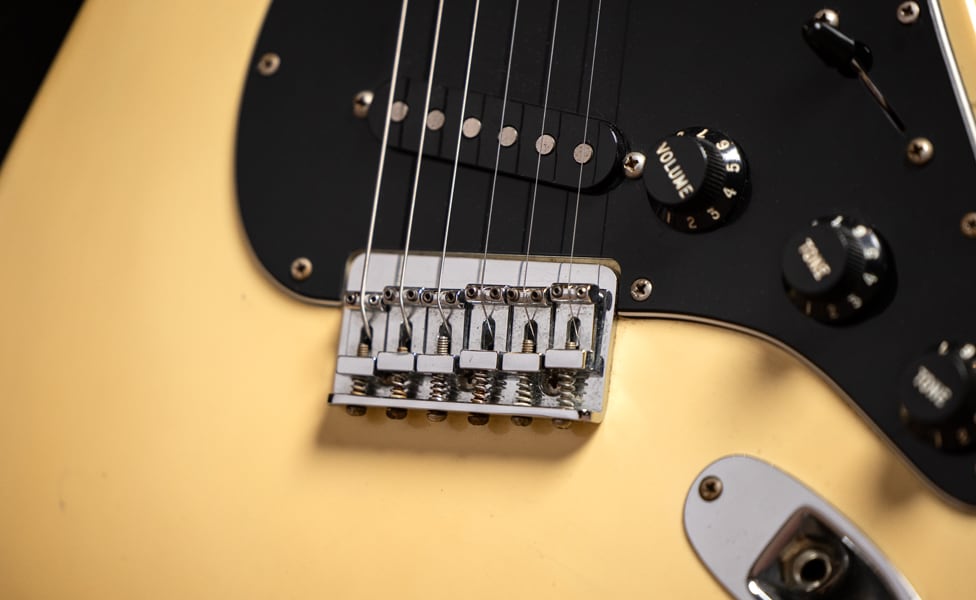
Pictured: 1980 Fender Stratocaster Hardtail Bridge
Randall had left Fender and CBS in 1969, but his views were prescient. By 1984, CBS was looking to sell Fender and divest itself of all its music gear holdings. Layoffs began in earnest, and in February 1985, CBS sold its “unprofitable Fender musical instruments unit” (as reported by the New York Times) to an investment group lead by William Schultz, who was then Fender president.
Schultz acquired the brand for $12.5 million—a bargain, as that number was half a million dollars less than what CBS had paid Leo Fender for his company in 1965. Fender was rechristened as Fender Musical Instruments Corporation—the name it has today—and Schultz and his team brought renewed respect, increased innovation and even greater glories to Leo’s namesake brand. But that story is another chapter, for another day …
Back to the '70s
If you want to explore actual Stratocasters from the CBS era yourself, you can always peruse the Guitar Center vintage Stratocaster collection. However, if you’re looking for the retro vibe of CBS Strats, but are more comfortable with modern construction, try out the recreations in the Fender Vintera II, Fender American Vintage II or Squier Classic Vibe lines. And, of course, few things beat visiting your local Guitar Center to experience some ’70s Strat magic. Don’t forget your bell bottoms.
.jpeg)






